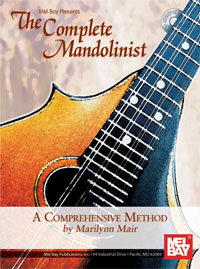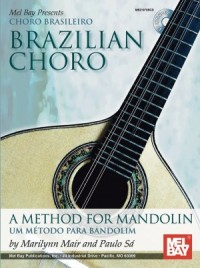This article was originally published in “Mandolin Quarterly,” 2003, Vol. 8 Nr. 3.
Download the pdf of the sheetmusic associated with this article: Brejeiro
Of all the early choro composers, Ernesto Nazareth (1863-1934) was certainly the most influential. Hector Villa-Lobos (1887-1959) called him, “the true incarnation of the Brazilian musical soul.” Nazareth was born in Rio de Janeiro on March 20th, 1863. His mother was a pianist, and as a child he learned to play the popular polkas, waltzes and Portuguese modinhas (sentimental songs) of the day, along with the music of Chopin, Mozart, and Beethoven. After his mother’s death in 1873, his musical education was continued by family friends, Eduardo Madeira and Lucien Lambert.
Nazareth began writing solo piano music while he was still a teenager, and published his first polka, “Você Bem Sabe” when he was 14. Along with his music lessons, he was also influenced at the time by Brazilian street musician playing the new style of choro. Nazareth developed a musical style that combined polkas and modinha with the Spanish habanera, and the rhythm of the maxixe, a wild and sensual Brazilian dance. He called his compositions “Brazilian tangos,” a designation that became his trademark.
In 1886 Nazareth married, and he supported his family by giving piano lessons and playing social music. He had four children, and at one point, in order to pay the bills, he sold the rights to some of his compositions, including “Brejeiro,” which soon became a big hit in Paris. In 1920, Nazareth got a job demonstrating sheet music for a music publisher, playing pieces as requested by customers, to help them decide which ones to purchase. This was a necessary service since there was no radio and records were rare, so music popularity was determined by sheet music sales. Of course Nazareth promoted his own music as well, and was soon deluged with young performers playing his composition for him on the store pianos.
A few years later, he began to play solo piano in the lobby of the famous Odeon cinema an hour before the movies began. He wore tails, and his repertoire included Chopin, Liszt, Gottschalk, and Beethoven, as well as his own compositions. He sometimes played with a small orchestra that included Heitor Villa-Lobos on cello. Villa-Lobos, who had already begun composing choro, would go on to become the most famous of Brazil’s classical composers, the work of Nazareth and choro clearly evident in his music. Nazareth influenced other Brazilian composers as well, including jazz composer Radamés Gnattali, as quoted in an interview, “Nazareth played at the Odeon and those who could not pay stayed in the street, listening. Some time later I met him at the Galeria Cruzeiro. There was a shop on the side facing Largo da Carioca, that sold pens, paper and also pianos. Nazareth used to play there during the afternoon. Once I came near him and played for him. He was interested.”
Nazareth’s wife died in 1929, and Nazareth began showing signs of depression that would later develop into debilitating insanity. By 1932, his health was deteriorating, he was deaf in the right ear, and his mental instability increased until he was hospitalized for serious emotional problems. In February, 1934, he escaped from the mental hospital where he was a patient and was found dead in the woods a few days later.
Nazareth’s contribution to the development of Brazil’s national music style cannot be overestimated. In his nearly 300 short piano works, Nazareth captured the essence of popular Brazilian dance music, and combined it with the European style of Chopin, the dramatic flare of New Orleans composer Louis Morreau Gottschalk, and the syncopation of Brazilian street musicians and North American ragtime. Despite its complexity, the piano music of Nazareth achieved great popularity due to his popular-style melodies and rhythms. Nazareth’s works are still widely performed, and are some of the earliest compositions to be considered standards in the contemporary choro repertoire.
Contemporary Brazilian pianist and choro composer Luiz Simas is one whose career was strongly influenced by the music of Nazareth: “Since I was very little, in the 50’s, ‘Brejeiro’ and ‘Odeon’ somehow entered my subconcious through the radio, even though I didn’t know they were Nazareth compositions, or who Nazareth was anyway. Only after arriving in the US, in 1989, did I start playing his pieces from a piano folio. I used to perform solo piano in a Brazilian restaurant in Manhattan for happy hour, and his pieces were perfect for that atmosphere. It was then that I noticed the similarities between ragtime and choro. Since then, his music has inspired me a lot, and as a direct consequence I wrote the chorinhos that I recorded in my ‘New Chorinhos from Brazil’ CD. I find his music at the same time catchy and rich, full of beautiful melodies and harmonies, and with very clever rhythmic solutions for the piano. He has a high sense of form and unity, and there’s never a boring moment. At the present time I’m especially enthralled with his maxixe ‘Fon-Fon’.”
Nazareth wrote for a sophisticated urban audience in Rio, combining the style of European salon music with the rhythmic influence of Afro-Brazilians, especially after 1888, when slavery was abolished in Brazil. Although he called his pieces “tangos,” they are not based musically on the Argentine tango, but are actually more similar to Brazilian maxixe or choro in form and style. Nazareth felt, justifiably, that his compositions were more refined than contemporary Brazilian popular music forms, and so he preferred to describe them with his self-designation, “Brazilian tango”. It’s interesting to note that Nazareth was nearly an exact contemporary of American ragtime composer Scott Joplin (1868-1917), another pianist who created an original and influential syncopated national music style in the Americas.
Paulo Sa, Brazilian jazz mandolinist, contributed this assessment: “Well, about Ernesto Nazareth, in a great part he was self-taught in piano. But his compositions reveal Chopin’s atmosphere and melodic inflections. He developed a very special way of playing piano using Brazilian syncopation together with his Chopin influence, and the result was amazing. After his tragic death (and Pixinguinha, a young musician at that time, was called to recognize the body because the were friends) Nazareth was almost forgotten by classical pianists. By the 1950’s, Francisco Mignone and Radamés Gnattali (composers and pianists who belonged to classical and popular music, and sometimes were criticized for that, especially by classical musicians) were responsible for the revival of his compositions by classical pianists who, for a long time, considered Nazareth a popular musician. Although Nazareth’s pieces are essentially for piano, many of his melodies were being played by Choro groups before classical musicians rediscovered his magic compositions. Jacob do Bandolim stated once that Nazareth and Pixinguinha were the most important musicians for the development and consolidation of Choro. Jacob’s composition “Ao som dos violões” is based on Nazareth’s melodic inflections. Today Ernesto Nazareth is one of the most important essences of Brazilian music, because he represents the hybrid consolidation, the fusion of European music (tangos, polcas, valses) into Brazilian music.”
“Brejeiro,” that I have included here in lead-sheet form, is one on Nazareth’s best known choro. It was written in 1893 as a solo piano work, and quickly became a favorite of brass bands and choro ensembles as well. The title means “flirtatious,” and it is a lively, striding piece, similar in style to a ragtime “cakewalk”. You can play it on mandolin, with piano or guitar accompaniment, or with a band, as the accompaniment is “realized” from the chord symbols. Be sure your accompanist recognizes the implied traditional choro accompaniment rhythm patterns evident in the melody, especially measures #1, #14, and #37 (the standard choro rhythm). Enjoy!



